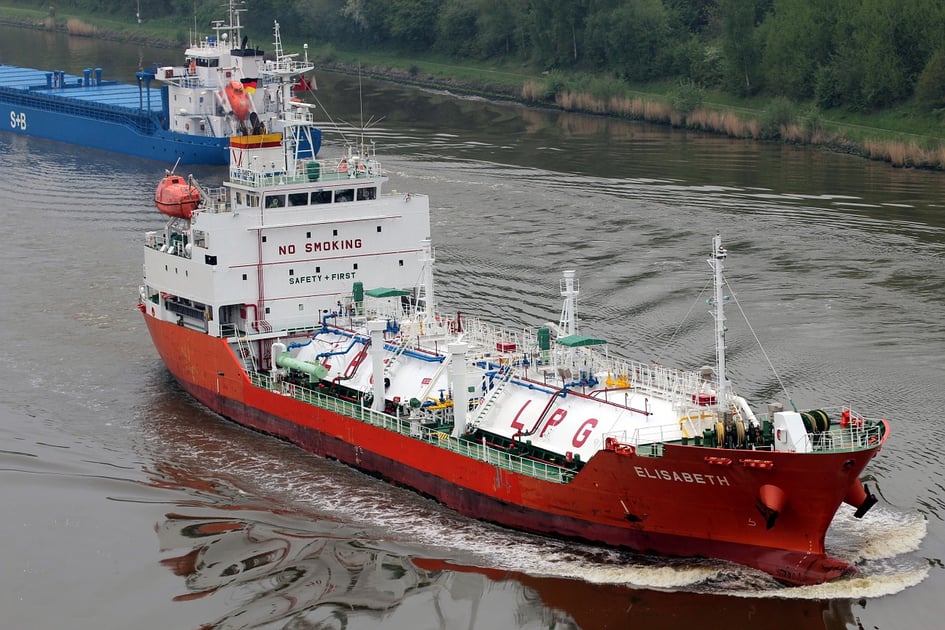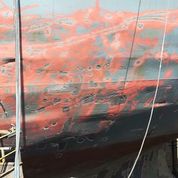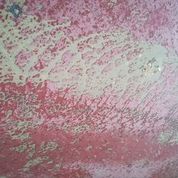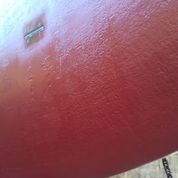Ship Corrosion Case Study: Factors for preserving & coating ships hulls
April 8, 2021 •Corrosion CONTROLLED, Corrosion Essentials, Coatings

This case study illustrates what can drive the selection of the right biofouling solution
The damages and losses of speed and efficiency that can be caused by the presence of fouling on a ship’s hull—more specifically on the bottom below the waterline—are well known. The attachment of fouling is aggravated when the ship is docked for a long time without the opportunity to navigate and to allow the antifouling coatings to achieve their purpose, which is losing the materials with the assistance of moving water.
Ship hull preservation and coating requires ship owners to consider:
• Cleaning processes used to remove biofouling and other contaminants;
• Surface preparation: methodology choice, cost vs. efficiency; and
• Coatings: total removal and recoating or repainting.
The case study that follows will illustrate these considerations.
On this particular ship, the hull above the waterline was very damaged and eroded due to years of dock or fender impacts. Corrosion was present in almost 30% of the overall area. Section reduction of the steel plates was verified and could be seen with the naked eye. Below the waterline, there was a massive concentration of biofouling, mainly calcareous biofouling. In addition, signs of corrosion were also visible. No anodes were present, indicating the presence of impressed current
cathodic protection; the anodes were either turned off or inefficient.
Methodology
Above the waterline, methods included the following:
• Pressure washing up to 500 bar (7,252 psi) of all hull areas;
• Spot blasting per Sa 2½, according to International Organization for Standardization (ISO) 8501 of corrosion spots, two layers of spot coating to approximately 30% of the overall area, and one general layer of finishing coating to all areas;
• As additional information, about 90 m2 (969 ft2) of steel plates in the hull were replaced due to the lack of thickness and deformation caused by impacts.
Below the waterline, methods included:
• Pressure washing up to 500 bar of all hull areas;
• Scrapping biofouling in spot areas with tighter biofouling;
• Power tool cleaning up to degree per St 3, according to ISO 8501, two layers of spot coating up to 5% of the overall area, and two general layers: one sealant and one finishing coating antifouling silicone based.
Attention is focused on coatings below the waterline as this is an area important for ship performance — specifically, speed and fuel efficiency, both of which are key factors in the overall efficiency of vessel performance and its cost effectiveness.
Pressure washing was not effective in this area. Years of docking were harmful for the antifouling; hard biofouling was attached to the vessel hull and was very difficult to remove. More incisive actions (e.g., persistent pressure washing) damaged the coating, making scratches as the rotational water jet passed. Having noticing this, the ship owner, with input from the coating manufacturer, decided to scrape. However, calcareous residues remained in the coating.
While other options were available, such as power tool sanding, grit sweeping, or blasting to bare steel, they were not used possibly due to cost or time constraints. Regardless, the owner decided on pressure wash cleaning again, spot blasting, and repainting per the specification.
Conclusions
These solutions, techniques, and their execution did not follow best practices:
• Damage or sensitive paint was not removed;
• Mud cracked coatings remained and were overcoated;
• Edges were not feathered and in fact, poor coating conditions would not allow for it;
• Coating delamination due to solvent sensitivity of subsequent coating layer was not removed; and
• Final silicone coating roughness, caused by underneath old coating
poor conditions, was not considered as a relevant factor.
What then, drove the owner to the biofouling solution chosen? (See Table). On the one hand, a rise of 10 to 20 μm (0.4 to 0.8 mils) in the antifouling finishing layer roughness (Rz) can increase up to 1% total resistance experienced by a ship in navigation. Moderate concentration of fouling in a ship hull can reduce cruising speed by more than 10% and increase fuel consumption and manmade gas emissions to the atmosphere.
On the other hand, a total coating removal, including total blasting and the application of a more effective coating, could have increased maintenance costs, including unavailability periods and higher
drydock costs.
Techniques, technicians, equipment, and materials are always available despite time constraints. An effective intervention allows for the best result in a shorter period, reducing the risk of loss and damages for the intended period between maintenance procedures.

IMAGE 1: Hull damage visible after blasting

IMAGE 2: Damage caused by pressure water jetting

IMAGE 3: Final layer of coating on hull bottom
The real concern should be to ensure that proper corrosion protection
is performed. Standards such as those from ISO and NACE International, can and should be used to ensure proper performance. There should be a balance between maintenance and unavailability
costs and production losses or, in a worst case scenario, total material (i.e., vessel) loss.
Solution Consequence Decision Driver
| Pressure water cleaning & scraping, spot blasting, & general coating |
Defective coating remains, introducing delamination in new coating & general coarse roughness in final coating |
Less dry dock time, less cost | ||
| The corrosion protection of the vessel hull under waterline will be more dependable in CP | 1) Use less expensive - although less efficient - cleaning & surface prep system; 2) Availability for new shipping's earlier 3) Maintenance schedule, new dry docking |
Get more information on this industry with a free subscription to AMPP’s Maritime News.
Source: Originally appeared in Maritime News, Spring 2020; authored by Ricardo Jorge Carvalho Soares, Civil Engineer and COO at MONTACO, S.A.
FREE DOWNLOADS
White Paper: An Action Plan for Reducing Pipeline Failures, Costs with Corrosion in the Water Sector
Special Report: The Future of Corrosion Control, Insights from the Experts
Get Updates
Featured Articles
Categories
- 2024 Olympics (1)
- 2024 Water Resource Development Act (1)
- Abrasive Blasting (1)
- Advanced coating materials (9)
- advanced coatings (1)
- Advanced Corrosion Control in Oil and Gas Industry (2)
- Advocacy (3)
- AI (2)
- Aircraft (1)
- Alkanization (1)
- AMPP (4)
- AMPP Annual Conference + Expo (5)
- ampp awards (1)
- ampp certification (2)
- Ampp Chapters (1)
- AMPP conference (1)
- AMPP logo (1)
- Ampp Membership (2)
- Ampp Standards (3)
- ampp training (2)
- Amusement parks (4)
- Architectural (1)
- Architectural Coatings (2)
- argonne national laboratory (1)
- Artificial Intelligence (1)
- Asset integrity (12)
- Asset maintenance (3)
- Asset Protection (1)
- awards (3)
- B2B Marketing (1)
- Bim Software (1)
- Biodeterioration of materials (5)
- Biofouling (4)
- Blasting (1)
- Bridges (4)
- career advancement (3)
- career development (2)
- cathodic protection (2)
- Cathodic Protection-CP (16)
- Ceramic epoxies (1)
- Certification (3)
- certification study guide (1)
- Chemical Injection (1)
- CIP (1)
- Civil Engineering (1)
- clean energy (1)
- Coating inspector (2)
- coating inspector job roles (1)
- Coating inspector jobs (2)
- Coating inspector program (2)
- Coatings (18)
- Coatings Application (3)
- coatings certification (1)
- Coatings failures (2)
- Coatings Industry (2)
- coatings inspection (1)
- Coatings inspector (2)
- Coatings measurement and inspection (9)
- coatings project management (1)
- Coatings Systems (1)
- Cold stress (1)
- Concrete (13)
- Concrete corrosion (1)
- concrete cracking (1)
- Conference and Events (2)
- Corrosion (26)
- Corrosion Basics (5)
- corrosion certification (1)
- Corrosion Control (17)
- Corrosion Control and Management (23)
- Corrosion detection (1)
- corrosion engineering (1)
- Corrosion Essentials (20)
- Corrosion Inspection (1)
- Corrosion Management (1)
- Corrosion Meaning (1)
- corrosion mitigation (1)
- corrosion of steel (1)
- corrosion policy (1)
- Corrosion Prevention (13)
- corrosion resistance (1)
- corrosion resources (1)
- Corrosion Under Insulation (2)
- cost of corrosion (1)
- Crevice Corrosion (1)
- Cui (2)
- Data Monitoring (1)
- decarbonization (1)
- defense infrastructure (1)
- Department of Defense (4)
- Deposition corrosion (1)
- Dissimilar Metal Corrosion (1)
- Dissolved gases (1)
- DoD (3)
- Education (2)
- EMERG (1)
- Energy industry (9)
- entertainment industry (1)
- Epoxy (3)
- exam preparation (1)
- FBE Application (1)
- FBE Inspection (1)
- Fireproofing (1)
- Flexible coatings (2)
- Flint, Michigan (1)
- Fluoropolymer coating (3)
- Forms of Corrosion (4)
- Freshwater salinization (1)
- Fusion-bonded epoxy (1)
- Galvanic (1)
- Galvanic Corrosion (4)
- General Corrosion (4)
- General Tips (1)
- Global supply chain resilience (1)
- glossary (1)
- Hand tools (1)
- honoree night (1)
- Industrial Application (3)
- Industrial Safety (3)
- Industry Best Practices (1)
- Industry Standards (2)
- Infrared Thermography (1)
- infrastructure (4)
- Infrastructure Durability (1)
- Inspection (1)
- integrity management (1)
- Intergranular Corrosion (1)
- International Maritime Organization (IMO) (1)
- Intumescent Coatings (1)
- key note speaker (1)
- leader (1)
- Machine Learning (2)
- Maintenance (2)
- Maintenance Best Practices (1)
- Maritime Coatings (11)
- Maritime industry (12)
- Maritime infrastructure (1)
- Master Painters Institute (2)
- material protection (1)
- materials performance (1)
- materials science (1)
- Membership (2)
- Membership Benefits (2)
- Michio Kaku (1)
- Microbiological forms (1)
- Microbiologically influenced corrosion-MIC (11)
- Military (2)
- Mineral constituents (1)
- MnDOT (1)
- MPI (3)
- mpi awards (1)
- mpi champion awards (1)
- mpi training (1)
- MPI Update (1)
- MR21506-2025 (1)
- National Defense Authorization Act (1)
- national security (1)
- Naval readiness (1)
- Navy (1)
- nickel-based alloys (1)
- Non-Destructive Testing (1)
- nuclear (1)
- nuclear Materials (1)
- nuclear reactor technology (1)
- Oil and Gas (2)
- Oil Fields (1)
- Organic matter (1)
- Oxgen (1)
- Paint and Protective coatings (32)
- Paint specification (1)
- pcs certification (1)
- Personal Protective Equipment (3)
- Petrochemical Plant Fireproofing Methods (1)
- Petrochemical Plants (1)
- Pipeline (2)
- Pitting Corrosion (2)
- Pitting Detection (1)
- Polymer-Based Coatings (1)
- Power plant (1)
- Power tools (1)
- PPE (3)
- Print Advertising (1)
- Print Marketing Strategy (1)
- professional certification (2)
- professional development (1)
- Protecting oceans (1)
- Protective Coatings (7)
- protective coatings industry (1)
- protective coatings specialist (1)
- quality assurance (1)
- radiation-resistant materials (1)
- Real-Time Corrosion Monitoring in Oil Fields (1)
- Rebar Corrosion (2)
- rectifier (1)
- Reliability (1)
- Remote monitoring and drones (4)
- Repaint (1)
- Restoration (1)
- ride maintenance (1)
- Risk-Based Inspection (1)
- Road deicers (1)
- Roads and bridges (1)
- Roller coaster (1)
- Rust (1)
- sacrificial anodes (1)
- Safety (5)
- Safety Standards (3)
- Salt pollution (1)
- Sensors (1)
- service awards (2)
- Ship Coatings (9)
- Shiptanks (1)
- Solvent-free coatings (1)
- Standards (10)
- Standards Committees (2)
- Steel (8)
- Steel Reinforcement (2)
- Stress Corrosion Cracking (1)
- Structural Steel (1)
- study tips (1)
- Surface Preparation (13)
- Sustainability (2)
- Sustainability and corrosion (7)
- terminology (1)
- Tools (1)
- Turbine (1)
- Types of Corrosion (1)
- Ultrasonic Testing (1)
- Uniform Corrosion (1)
- us army core of engineers (1)
- Wastewater Systems (1)
- Water crisis (1)
- Water pipe corrosion (1)
- Water quality (1)
- Water tank coatings (5)
- Water/treatment infrastructure (20)
- Waterway salinity (1)
- What Is Corrosion (1)
- Workforce development (1)
- WRDA (1)
